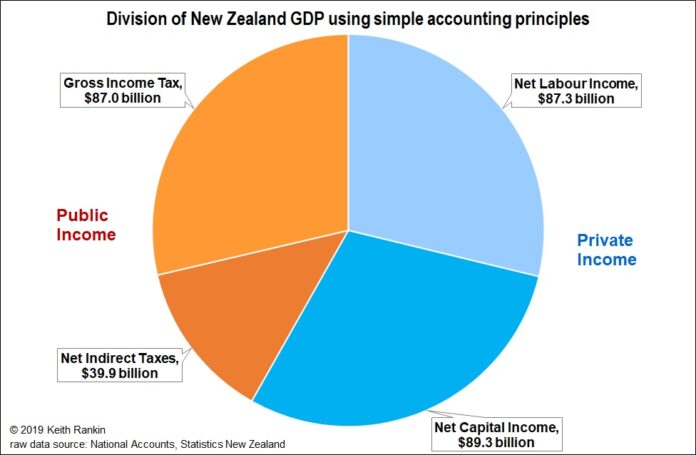When the annual national accounts were released by Statistics New Zealand, the $300 billion milestone was released. New Zealand now produces, for sale, goods and services valued at more than $300 billion in one year.
Ownership of the gross domestic product (GDP) is called ‘income’. Deciding who, at first cut, owns those goods and services is a matter of the accounting principles adopted. Here, applying Occam’s Razor, I favour the simplest accounting interpretation.
(We may note that there are two subsequent redistributions: the first redistribution relates to benefits and transfers; the second ‘deficit/surplus’ allocation relates to the process of some parties’ spending more than their post‑transfer incomes [deficit spending] offset by others who spend less than their incomes.)
The official national accounts acknowledge three main income funds, though in a convoluted way: private capital income (“operating surplus”), labour income (“compensation of employees”), and public income (“taxes”). The ‘convolution’ is the official practice of only acknowledging “indirect taxes” as public income. Direct taxes lie hidden within the two big private funds, with direct taxation being treated as a redistribution; a redivision that is too complex for the national accounts because – thanks to graduations and exemptions – each individual taxpayer is levied at a personalised tax rate.
This month’s chart simply applies the 33 percent tax rate that has been the cornerstone rate of income tax in New Zealand since 1988. In doing so, there is no claim that 33% is the optimal tax rate; the 33% rate is what it is, for better or worse. (Australia’s cornerstone rate is 37 percent.)
The blue portions of the chart represent unambiguous private income; income (already taxed) sourced through the marketplace. The capital and labour shares are roughly equal, and have been for some time. Together they make up 58 percent of GDP. (Note that the private sector includes net foreign claims on New Zealand’s GDP.)
The orange-shaded portions are public income. ‘Net indirect taxes’ are unambiguously public. ‘Gross income tax’, is calculated as 33 percent of ‘gross labour income and ‘gross capital income’. It arises from the application of simple, commonsense, national accounting. The public income share amounts to 42 percent of 2018/19 GDP.
Where does the public income share go? A sliver is saved, as the government’s fiscal surplus; this means that the private sector enjoyed some deficit spending in 2018/19.
A much bigger share of public income is spent directly by government, on collective goods and services such as education and healthcare.
The biggest share of public income is allocated to private parties as benefits and transfers. The biggest single component is the unconditional benefits granted as income tax concessions. Present distributional rules on benefits and transfers favour people at both ends of the income spectrum, but not hugely.
Rearranging this in favour of a more equal public distribution need not be an expensive exercise. Further, such a rearrangement has the potential – a result of the simplification process – to reduce permanently the demand for public administration services. The principal beneficiaries of such a rearrangement would be lower‑middle income households, and the young people struggling to make the transition from private dependence to autonomous adulthood. The National Party could be promising that, if able to form a government in 2020, they will simplify public benefits in lieu of a more conventional tax reduction policy.
There is a sound argument that, so long as productivity is a significant contributor to increased GDP, the public income proportion of GDP should be increasing over time. This argument suggests that the 33 percent tax rate is a little bit on the low side. My sense is that the underlying public contribution to GDP is more like 45 percent than 42 percent. While a tax rate of 36.5 percent would yield such a 55:45 private:public distribution split, policy priority should probably favour simplification over tax increases.









